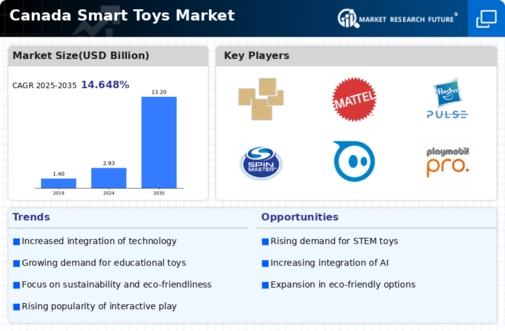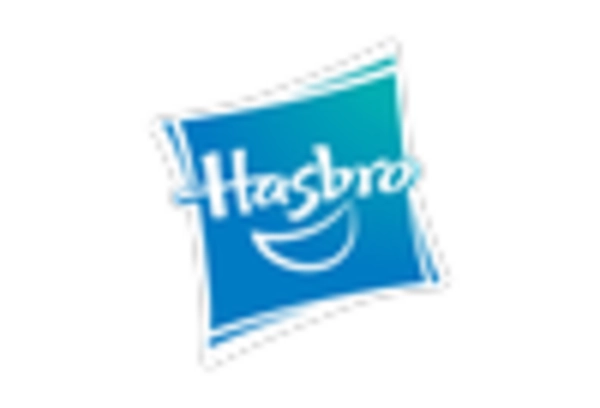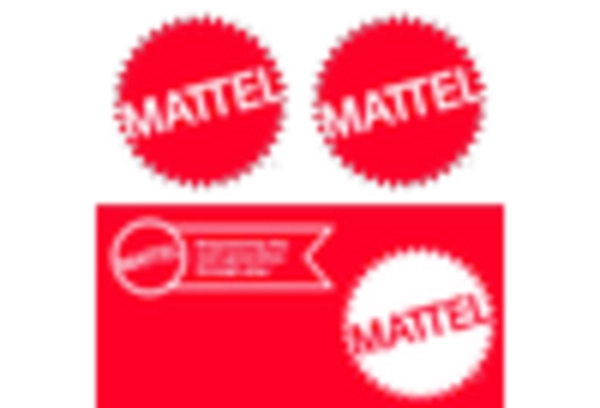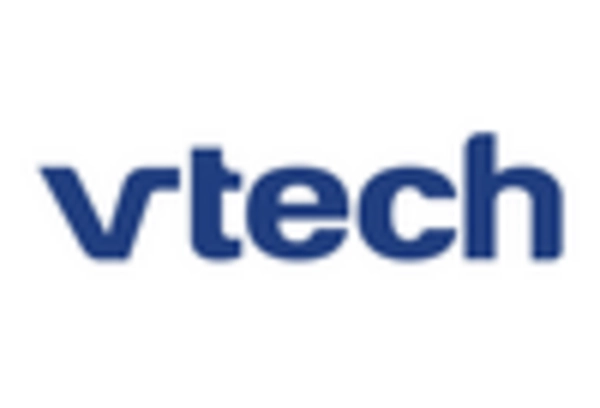Focus on STEM Education
The emphasis on STEM (Science, Technology, Engineering, and Mathematics) education in Canada is significantly influencing the smart toys market. As educational institutions and parents alike recognize the importance of fostering STEM skills from an early age, there is a growing demand for toys that promote these disciplines. Smart toys that incorporate coding, robotics, and problem-solving activities are particularly appealing to parents seeking to prepare their children for future challenges. Market Research Future suggest that the segment of toys designed to enhance STEM learning is expected to grow by approximately 20% over the next few years. This focus on STEM education is likely to drive innovation within the smart toys market, as manufacturers develop products that align with educational standards and parental expectations. Consequently, the smart toys market is becoming increasingly aligned with educational initiatives aimed at equipping children with essential skills.
Rise of Digital Learning
The rise of digital learning platforms in Canada is significantly impacting the smart toys market. As educational institutions increasingly incorporate technology into their curricula, parents are seeking toys that complement this digital learning environment. Smart toys that offer interactive learning experiences are becoming essential tools for reinforcing concepts taught in schools. Market analysis indicates that the demand for educational toys has surged by approximately 25% in recent years, reflecting a shift towards integrating play with learning. This trend is likely to continue, as parents and educators recognize the value of smart toys in enhancing children's learning experiences. Consequently, the smart toys market is poised for growth, driven by the need for products that support educational outcomes while providing entertainment.
Influence of Social Media
Social media platforms are playing a pivotal role in shaping consumer preferences within the smart toys market in Canada. Influencers and parenting blogs frequently showcase innovative smart toys, creating a buzz that drives consumer interest. This exposure is leading to increased visibility for brands that prioritize technology and interactivity in their products. Market data reveals that approximately 60% of Canadian parents are influenced by social media when making purchasing decisions for toys. As a result, companies are investing in marketing strategies that leverage social media to reach their target audience effectively. This trend not only enhances brand awareness but also stimulates demand for smart toys, as parents are more likely to purchase products that are trending online. The impact of social media is thus a crucial driver for the smart toys market.
Increased Parental Awareness
In Canada, there is a growing awareness among parents regarding the developmental benefits of smart toys. Parents are increasingly recognizing that these toys can foster cognitive skills, creativity, and social interaction in children. This heightened awareness is influencing purchasing decisions, as parents are more inclined to invest in toys that offer educational value. Market data suggests that approximately 70% of Canadian parents prioritize educational features when selecting toys for their children. This trend is likely to propel the smart toys market, as manufacturers respond by creating products that align with parental expectations. Furthermore, the emphasis on safety and quality in smart toys is becoming paramount, as parents seek assurance that the toys are not only engaging but also safe for their children. This shift in consumer behavior is a significant driver for the smart toys market.
Technological Advancements in Play
The smart toys market in Canada is experiencing a surge due to rapid technological advancements. Innovations in artificial intelligence, augmented reality, and interactive features are transforming traditional toys into engaging learning tools. For instance, toys that adapt to a child's learning pace are becoming increasingly popular. This trend is reflected in the market data, which indicates a projected growth rate of approximately 15% annually over the next five years. As parents seek educational value in playtime, the demand for technologically advanced toys is likely to rise, driving the smart toys market further. Moreover, the integration of mobile applications with toys enhances user experience, making them more appealing to tech-savvy families. This evolution in play is reshaping the landscape of the smart toys market, positioning it as a key segment in the broader toy industry.

















Leave a Comment